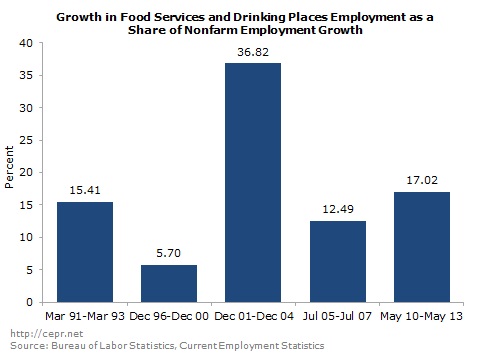June 07, 2013
June 7, 2013 (Jobs Byte)
By Dean Baker
Weak productivity growth has supported the job growth of the last two years.
The May jobs numbers were in line with expectations with the Labor Department reporting 175,000 new jobs. There were modest downward revisions to the sum of the prior two months data, bringing the average over the last three months to 155,000. The unemployment rate was essentially unchanged at 7.6 percent.
Job growth was again narrowly concentrated, with the restaurant sector (38,100 jobs), retail trade (27,700) and temporary employment (25,600) accounting for more than half of the job growth in May. These are all low-paying sectors. It is worth noting that the job growth reported in these sectors is more an indication of the weakness of the labor market than the type of jobs being generated by the economy. The economy always creates bad jobs, but in a strong labor market workers don’t take them.
The professional and technical services sector, which has shown strong job growth this year, added 18,200 jobs in May. The health care sector added just 10,700 jobs, less than half of its average over the last year. This is likely an aberration. On the other side, education services added 14,200 jobs, bringing its three month total gain to 42,400. That follows five months in which the sector lost 34,100 jobs, likely a problem of seasonal adjustment.
The big gainer in retail was general merchandise, which added 9,700 jobs. This sector has added 42,900 jobs since January after losing 66,800 over the prior year. The government sector had a net job loss of 14,000 federal jobs and 2,000 state jobs more than offsetting an increase of 13,000 jobs at the local level. Federal employment is down by 73,000 from its year-ago level and 124,000 (4.3 percent) from its level of two years ago.
There was no change in the duration of the average workweek and average hourly wage growth remain weak, rising at a 1.4 percent annual rate over the last three months. That’s down from a 2.0 percent rate over the last year.
On the household side, there were few noteworthy changes from the April data. The rise in the unemployment rate was not close to statistically significant; the rate has been essentially the same for the last three months. As in prior months, the gains in employment went disproportionately to older workers. Employment of workers of age 55 accounted for 203,000 of the 319,000 gain in employment reported for May. Over the last year they have accounted for 1,205,000 of the 1,596,000 reported rise in employment. Since employment bottomed out in December of 2009, older workers have gotten 4,205,000 of the 5,673,000 growth in employment or 74.1 percent.
There was no clear trend in the duration measures for unemployment, with the average edging higher, but the median and share of long-term unemployed both falling slightly. All are well below year-ago levels, but this is due to the shortening of the benefit period which caused many of the unemployed to drop out of the labor market.
By educational attainment the less-educated continue to do surprisingly well. The unemployment rate for workers without high school degrees fell by 0.5 percentage points to 11.1 percent, reversing a rise of this size the prior month. The unemployment rate for college grads edged down slightly to 3.8 percent, which is still close to double its pre-recession level.
The percentage of unemployment due to people voluntarily quitting their jobs rose 0.7 percentage points to 8.1 percent partially reversing a 1.0 percentage point drop in April. This is still an unusually low level, indicating workers do not feel comfortable in leaving a job without a new job lined up.
The job growth this year has been respectable, albeit weak for a recovery from a severe recession. However it is difficult to reconcile with an economy that is growing at a 2.0 percent rate, or possibly less. The data show a plunge in productivity growth to less than a 1.0 percent annual rate over the last two years. This could be due to workers being forced to accept low pay, low productivity jobs, but it would be very bad news if it were indicative of a longer term trend.







